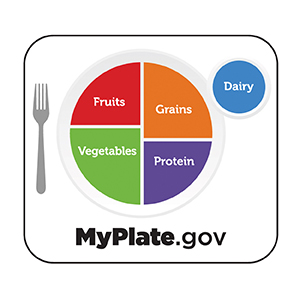Nutrition: School-Age
Helpful feeding information for your school-age child
School-age children (ages 6 to 12) need healthy meals and nutritious snacks. They have a steady but slow rate of growth and usually eat 4 to 5 times a day (with snacks). Many food habits, likes, and dislikes are set during this time. Family, friends, social media, and other media (chiefly via TV and tablets) affect their food choices and eating habits. School-age children are often willing to eat a wider variety of foods than their younger siblings. Eating healthy after-school snacks is important, too, as these snacks may contribute up to 1/4 of the total calorie intake for the day. School-age children can also help with meal prep.
Helpful mealtime hints for school-age children
These are some helpful mealtime hints:
-
Always serve breakfast, even if it has to be "on the run." Some ideas for a quick, healthy breakfast include:
-
Fruit
-
Milk
-
Bagel
-
Toast
-
Cereal
-
Peanut butter sandwich
-
Overnight oats
-
Take advantage of big appetites after school by serving healthy snacks, such as:
-
Set good examples for eating habits.
-
Let children help with meal planning and preparation.
-
Serve meals at the table, instead of in front of the TV. Also put away cell phones and tablets to prevent distractions.
Healthy food choices
The MyPlate icon is a guideline to help you and your child eat a healthy diet. MyPlate can help you and your child eat a variety of foods while encouraging the right amount of calories and fat.
The USDA and the U.S. Department of Health and Human Services have prepared the plate to guide parents in choosing foods for children age 1 and older.

The MyPlate icon is divided into 5 food group categories, emphasizing the nutritional intake of the following:
-
Grains. Foods that are made from wheat, rice, oats, cornmeal, barley, or another cereal grain are grain products. Examples include whole-wheat, brown rice, and oatmeal. Aim for mostly whole grains.
-
Vegetables. Vary your vegetables. Choose a variety of colorful vegetables, including dark green, red, and orange vegetables, legumes (peas and beans), and starchy vegetables.
-
Fruits. Any fruit or 100% fruit juice counts as part of the fruit group. Fruits may be fresh, canned, frozen, or dried, and may be whole, cut up, or pureed. The American Academy of Pediatrics recommends that children ages 4 to 6 limit fruit juice to 4 to 6 ounces daily, while children ages 7 to 18 should limit juice to 8 ounces or 1 cup of juice per day.
-
Dairy. Milk products and many foods made from milk, like yogurt and cheese, are considered part of this food group. Focus on fat-free or low-fat products, as well as those that are high in calcium.
-
Protein. Go lean on protein. Choose low-fat or lean meats and poultry. Vary your protein routine. Choose more fish, nuts, seeds, peas, and beans.
Oils are not a food group, yet some, like nut and other plant oils, have vital nutrients. They should be included in the diet in small amounts. Stay away from animal fats since they are solid fats.
Exercise and everyday physical activity should also be included with a healthy dietary plan.
Nutrition and activity tips
Here are tips to follow:
-
Try to control when and where food is eaten by your children by providing regular daily meal and snack times. Include social interaction and demonstrate healthy eating behaviors.
-
Involve children in picking and preparing foods. Teach them to make healthy choices by giving them a chance to choose healthy foods.
-
Select foods with these nutrients when possible: calcium, magnesium, potassium, and fiber.
-
Most Americans need to cut the number of calories they consume. When it comes to weight control, calories do count. Controlling portion sizes and limiting highly processed foods helps limit calorie intake and increase nutrients.
-
Parents are encouraged to provide recommended serving sizes for children.
-
Parents are encouraged to limit children’s screen time to no more than 1 hour daily. Instead, encourage activities that call for more movement.
-
Children and teens need at least 60 minutes of moderate to vigorous physical activity on most days for good health and fitness and for healthy weight during growth.
-
To prevent dehydration, encourage children to drink fluids regularly during physical activity and to drink several glasses of water after the physical activity is completed.
To find more information, visit Dietary Guidelines for Americans 2020-2025 and MyPlate.gov. Please note that the MyPlate plan is designed for people older than age 1 who do not have chronic health conditions.
Always talk with your child’s healthcare provider about your child's specific diet and exercise needs.
Online Medical Reviewer:
Heather M Trevino BSN RNC
Online Medical Reviewer:
Marianne Fraser MSN RN
Online Medical Reviewer:
Rajadurai Samnishanth
Date Last Reviewed:
1/1/2024
© 2000-2025 The StayWell Company, LLC. All rights reserved. This information is not intended as a substitute for professional medical care. Always follow your healthcare professional's instructions.